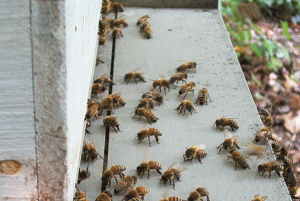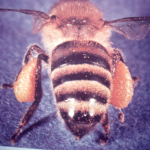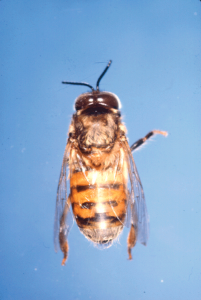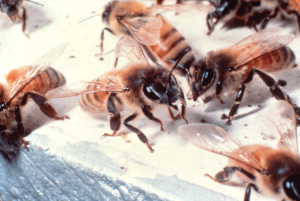By: Ann Harman
“And what is so rare as a day in June? Then, if ever, come perfect days.” James Russell Lowell, American poet, certainly said that right. Now take one or lots more of those perfect days and go out to your beeyard. Wear your veil (always) because you are going to have some fun and learn something at the same time. Learning from bees actually does happen every time you go to your hives but this time you are going to do some different things besides checking brood and queens. You will certainly need more than one day, but not necessarily very much time.
Make use of the whole month or more. Include sunny days, cloudy days, cool ones, hot ones and even rainy ones. Your assorted investigations will take place at various times from very early morning until nightfall, perhaps one even after nightfall. If there is a possibility of a thundershower, that time can be included, but not during any lightning. In some areas of the U.S. June is honey flow time and supers will be on hives. So a few of your investigations may need to be held at another time, after supers have come off or in the weeks or months before supers need to be put on. That’s fine. Actually you can do all or some of these projects any time during your bee season. In the areas with cold Winters wait for the sunny warm day when bees are taking cleansing flights to add to your observations.
Each colony of bees has its own ’personality.’ However, that can change with a replacement of its queen. It would be nice if you select two or three of your hives for various observations. A comparison of activities should be interesting. For some of the activities you will need more than one hive but if one is all you have at the moment, you can still make good observations.
Let’s start with observations at the entrance. These are best done when you are not going to open up your hives until later or on another day. Pull up a chair if you wish but don’t get in front of the entrance. Your bees are just having a normal day. Think about their normal activities from sunup until dark. Some bees will be returning as scouts as well as foragers for nectar and water. These returning bees will appear as if they are bringing in nothing so you really do not have any idea what their purpose was when they left the hive. You can certainly notice pollen foragers and, look closely, perhaps a few carrying propolis in their pollen baskets. Pollen looks colorful and is not shiny. Propolis generally looks somewhat shiny and brownish.
You will be making quite a number of visits to the entrance. You want to watch at different times of day. Choose those different times from dawn to nightfall – such as mid-morning late morning, early afternoon, mid-afternoon, late, at dusk. The middle of the day, when your sun is directly overhead and your shadow is right under your feet, is supposed to be the time when daytime foraging flight may be less. See what you notice at the entrance. Start with focusing on bees leaving and entering. You may wish to note the weather – sun, cloudy, cool, warm. Compare same times in different weather conditions. In the evening when do you see bees returning but not leaving? If you are fortunate to know of an approaching thunderstorm, make some quick observations to see if bees are returning but almost none leaving. Stay safe! Lightning is not to be trusted!
Are bees always good pilots? Choose a time when flight activity seems to be fast and furious. Are all the bees managing their take-offs and landings gracefully and under control? Any crashes? Tumbles? Is there traffic congestion just inside the entrance? Put on your rain gear and see what activity you see in fog, mist and light rain. If flight activity is negligible do you see any bees waiting just inside the entrance? These could be guard bees but maybe other bees are waiting for the rain to stop.
Now it is time to focus on the pollen foragers when they are returning with full pollen baskets. Unfortunately many pollens are yellowish, tannish, pale orangish in color and can be hard to distinguish. You can try to capture a bee to have a better look but you do not want to interfere too much with their normal activity. Select a mid-morning time and a mid-afternoon time to make a comparison of colors and numbers of bees returning with pollen. Make those pollen observations at least once a week for several weeks. You may notice differences in colors and in numbers of foragers.
During your entrance-watching you may see undertaker bees working very hard to drag a dead bee out. Watch what happens to the dead one. Does it get shoved over the edge of the landing board? Sometimes it may be picked up by one bee and flown a short distance away before being dropped. Note where the dead bee finally landed. Come back the next day and see if it is still there. Scavengers are very efficient. Tear a few small scraps of colorful paper and drop them into a hive through the hole in the inner cover. Sometimes the bees remove the scraps quickly and you can see them at work getting them through the entrance.
Next you are going to focus your attention on the flight paths. Here is a good opportunity to make comparisons using different hives. Select one hive and find the direction of flight for bees leaving. Now walk to another hive. Same direction or somewhat different direction or really different one? If you have several hives go ahead and notice the directions of each one. Do comparisons mid-morning and repeat in mid-afternoon. Wait a few days and repeat. Then wait a couple of weeks and repeat. Wind and nearby foliage can affect flight directions. Do you know of a rich nectar or pollen source reasonably nearby, perhaps your own flower or vegetable garden? Those can be a part of another set of observations.
For some of your projects you need a set of queen marking pens. No, queens will not be marked for your observations but you will have learned how to do it by marking drones. You might also wish to buy a small jar of paint used for painting model trains and other models. It will be easier to use this jar than using the marking pens in one of your investigations. Just before using the pens shake them very well. Then shake them again. You will also need to shake the jar of paint.
First, here is a brief review of drone behavior. Remember – drones do not sting! They have no stinging apparatus. So do not use gloves. You really do not want to harm them. Physically they are larger than workers and have big eyes that meet on the top of the head. When adult drones emerge from their cells they will not leave the hive for mating trips for about a week. They need that time to become sexually mature. The drones you are going to use for your project will be not be caught inside the hive. You will catch drones either leaving or returning on the landing at the entrance. Perhaps in your observations at the entrance you have discovered that drone flight takes place late morning to mid-afternoon.
To mark drones (also queens and workers) you want to put a dot of paint on the top of the thorax. It does not take much paint. You do not want to get paint on the head or abdomen or wings. Before attempting to mark a drone, practice handling them gently and getting them in position to be marked. You can, of course, use one of the queen-marking cages available from equipment suppliers.
Now for some fun. Assign a different color to each hive you are going to use for marked drones. You can catch and mark as many drones as you wish, but try to do at least six or seven per hive. Hold the drone for a short time right after you put a dot on to let the paint dry. We know that drones drift from hive to hive, and some workers do too. You will be watching at the entrances for marked drones either leaving or entering. See if you find any ‘mixed-up drones,’ marked ones flying to or from other than their original hive.
When you have been watching activity at the entrance did you notice any guard bees? Only a small percent of bees approaching foraging age become guard bees. These can be recognized by their behavior. Sometimes they will hide just barely inside the entrance. But you can also see them on the landing area of the bottom board. They either stand, looking quite alert, with forelegs raised, or may walk around and stop and go on alert again. Perhaps you will see a guard encounter an incoming bee and examine her with antenna and forelegs. It is always interesting to see an incoming bee passing the ‘sniff test’ and then being allowed into the hive.
In late Summer when yellowjacket colonies have declined these workers may attempt to enter honey bee hives hoping for a meal. If you are lucky you might see several guard bees accost the yellowjacket. Various insects can pay a visit to the landing board during the warm months. So make your entrance observations throughout your bee season and see guard bees at work. They are on duty at night and will respond to your tapping a stick on the landing area. However, if you take a flashlight out so you can see, bees can indeed fly out but will drop to the ground and crawl – probably up your legs. They are not happy about being disturbed at night. If you have some red transparent film you can cover the lens of a flashlight. You will be able to see but the bees cannot.
Do you have a flower garden and a vegetable garden with flowers that bees like to visit? Here is where you will use that little jar of model paint. You will want a very tiny brush or a toothpick.
Find a flower that bees are enthusiastically visiting. Some of these bees are probably from your hives but a few may have their home elsewhere. It does not matter. You are going to try to get a dot of paint on the thorax of some foragers. Your dot may end up as a streak. That is better than getting a large messy drop. Mark as many as you wish. Try to find the flight path of the foragers to see if they are going in the direction of your hives. Then return to your hives and look at returning and leaving foragers and see if any are marked. You can briefly watch at the entrances for several days when foragers are actively flying.
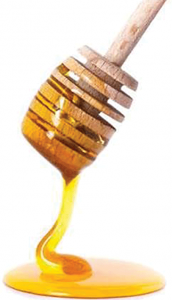 Bees recognize many kinds of odors in their own hive. Although your sense of smell is not as sensitive as the bees’ sense you can put on your veil and find out if you can detect any differences in hive odors. Pick a day when no honey supers are on as well as one that would be keeping foragers busy and also keeping the hive bees happy. Yes, a veil is absolutely necessary! Also, no smoke! Quietly remove the telescoping cover exposing the hole in the inner cover. Now bend over and take some slow deep breaths through that hole. Yes, you will have a mixture of wax, bees, honey combined. Now go and smell another hive – same or different? Just a few slow deep breaths before your sense of smell deadens. Now wait a month then smell again. Do you note any different smells? Perhaps the nectar source is different. Try to sense the smells during your bee season.
Bees recognize many kinds of odors in their own hive. Although your sense of smell is not as sensitive as the bees’ sense you can put on your veil and find out if you can detect any differences in hive odors. Pick a day when no honey supers are on as well as one that would be keeping foragers busy and also keeping the hive bees happy. Yes, a veil is absolutely necessary! Also, no smoke! Quietly remove the telescoping cover exposing the hole in the inner cover. Now bend over and take some slow deep breaths through that hole. Yes, you will have a mixture of wax, bees, honey combined. Now go and smell another hive – same or different? Just a few slow deep breaths before your sense of smell deadens. Now wait a month then smell again. Do you note any different smells? Perhaps the nectar source is different. Try to sense the smells during your bee season.
Speaking about bees’ sense of smell, you can have some fun with that if your beeyard is reasonably close by your house. You need a nice warm day with busy foragers, a small saucer, a watch and some time to sit quietly on your deck or patio and read a bee magazine. Put a couple of spoonfuls of honey in the saucer. This honey must not be any commercial honey that could contain American foulbrood spores. Take the saucer of honey out to your picnic table, sit down and note the time. Then note the time a bee appears and takes a sip of honey. Wait. Note the time the next bee appears and if more than one bee. That first bee was probably a scout bee that smelled the honey. She reported back to her hive and, dancing, told the others where to find the honey. You, sitting nearby, probably did not smell it at all.
Enjoy your bees and learn from them at the same time!







